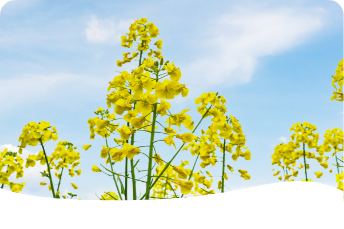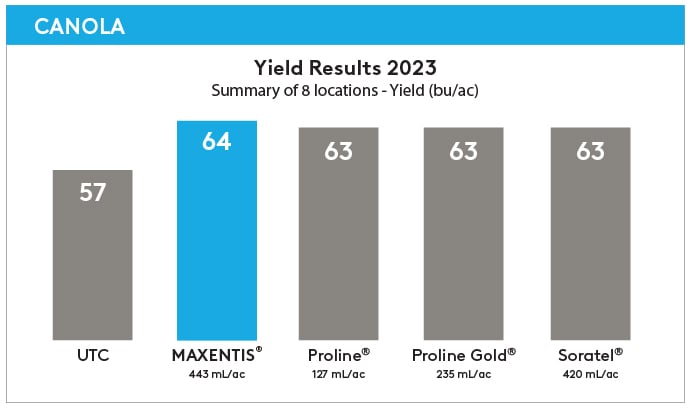WE ARE All In On Canola
At ADAMA, we know the best solutions come from listening to growers’ needs. With over 270 different active ingredients and the world’s largest library of actives, ADAMA is proud to offer Canadian canola growers a wide range of innovative, convenient options to maximize crop performance.
ADAMA offers two trusted fungicide options for canola: MAXENTIS® and BUMPER® 432 EC.
BUMPER® 432 EC is a cost-effective, broad-spectrum fungicide long trusted for early-season blackleg control in canola, safeguarding yield and quality during the rosette stage. MAXENTIS® delivers robust protection against both sclerotinia (white mould) and blackleg, ideal for growers looking for dual protection and effective resistance management.
Whether you opt for the proven reliability of BUMPER® 432 EC or the advanced dual-action of MAXENTIS®, ADAMA ensures year-long crop protection for optimal canola yields.

Canola Solutions
Learning Center
Control sclerotinia before it cuts your yields in half
Sclerotinia stem rot (white mould) continues to be one of the most devastating diseases in canola. By causing lesions on stems of infected plants, sclerotinia cuts off water absorption and nutrient uptake, reducing canola yield by as much as 50%.
The disease overwinters in soil and on crop stubble, and needs warm, moist soil conditions and plenty of shade to germinate. This means that the spread and severity of sclerotinia varies widely from year to year: dry, hot summers keep sclerotinia at bay, while humid, damp summers can lead to high levels of disease pressure.
In canola, timing is critical. For best results, fungicide applications such as MAXENTIS® should be completed before sclerotinia is found in the field. With a wide window of application and bulk easy-to-use formulation, MAXENTIS® lets growers spray industry-leading disease control faster and more efficiently when it suits them best. Asorbital® Formulation Technology ensures MAXENTIS® is absorbed and spread efficiently across the plant, providing long-lasting protection.
Identification
- Sclerotinia stem rot is characterized by bleached stem lesions and hard black bodies (sclerotia) of white mould fungus inside the stems.
- Infections that start on dead blossoms spread to adjacent tissues, resulting in dead branches or dead plants.
- Rotted stems usually have a bleached appearance.

Control tips
- Use clean, certified seed and crop rotations of at least four years. Include non-host crops such as corn, wheat, barley or oats in fields with a history of sclerotinia.
- As a preventative measure, consider wider row spacing when planting susceptible crops, like canola, in fields with a history of this disease.
- Keep fields free of broadleaf weeds since many are alternate hosts for this disease.
Disclaimer: Please read each label to determine which fungicide is appropriate for the crop affected.
Discover MAXENTIS®
Protect your yield quality and potential from blackleg
Blackleg is a serious disease known to cause up to 50% yield loss in canola fields. It can infect plants from the seedling stage onward, causing progressive damage as it develops cankers on the stem that restrict water and nutrient uptake.
The disease is often spread to crops through residues from infected plants and overwinters on infected stubble for at least two years. Wind and rain can also spread spores to new areas. Growers should be particularly cautious during warm, moist years or in regions that get a lot of rain, as these conditions encourage rapid spread. However, the disease is found both in warm, humid regions and dry regions across Canada, so it’s important to keep an eye out when growing susceptible plants.
Identification
 Source: The Canola Council of Canada
Source: The Canola Council of Canada- Cotyledon to two-leaf stage – Critical Infection Window
(A) Early stages present as white to yellow-brown lesions with pycnidia (black specks) on leaves. - Flowering stage
(B) The stem displaying varying degrees of black, as seen in this cross-section. - Ripening stage to post-harvest
(C) Late stages present with root and stem cankering (shrunken, pinched areas).
(D) Pseudothecia and pycnidia can be seen on old canola stubble.
Control tips
- Maintain a good crop rotation that has at least 3 years between canola crops.
- Plant less-susceptible varieties of canola. Most varieties are rated on a 1 - 5 scale (resistant to highly susceptible).
- Avoid confusing blackleg leaf lesions (which are speckled) with downy mildew lesions (which are not speckled).
- Use herbicides that control early season disease pressure during canola’s critical infection window, such as MAXENTIS® and BUMPER® 432 EC, to enhance yield potential and minimize loss if the disease reappears later in the season.
Disclaimer: Please read each label to determine which fungicide is appropriate for the crop affected.
Discover BUMPER® 432 EC Discover MAXENTIS®
Tips for improving weed control in canola
Weeds and volunteer crops are a significant threat to canola, acting as hosts for disease and pests while using up critical resources. With effective weed management, you can help protect your yield potential and maximize your investment on crop genetics, fertilizer and other crop input products.
- Scout early and often. Stay on top of emerging weeds, taking note of your biggest threats.
- Consider a pre-seed herbicide application like EMPHASIS® to help your crop get ahead of weed competitors. Additionally, weeds are easier to control when they are young and actively growing.
- Rotation, rotation, rotation. Rotate herbicide groups and follow proper crop rotation guidelines. Rotating to crops that allow for a wider range of herbicide groups and have different seeding and harvest timing (winter cereals, for example) is a very effective weed management strategy.
- Consider weed resistance. If weeds are growing through your herbicide applications (and you know you have made good contact), it may not be an issue with the herbicide. Have surviving weeds tested for resistance.
- Use tank mixes and find an effective grassy tank mix partner: Hitting weeds with multiple modes of action can help reduce the risk of herbicide-resistant weeds. If wild oats and other grassy weeds emerge before broadleaf weeds, it might be a good option to go in with a Group 1, then follow up later with your broadleaf or herbicide tolerant system. For heavier grass populations, in glufosinate-tolerant canola, we recommend ADAMA GLUFOSINATE 150 SL with ARROW ALL IN® as excellent options.
- Use the right herbicide at the right rate and time. Cutting rates, for example, may reduce herbicide efficacy and increase weed seed return to the soil seed bank.
- Get good coverage. Optimizing the effectiveness of glyphosate (and other herbicides) depends on getting good contact. Follow water volume recommendations, watch application speeds (<10 kmph) and ensure spray nozzles are in good working order and that you are optimizing droplet size to avoid drift.
- Control weeds throughout the season to reduce the deposit of weed seeds in the soil bank.
- Employ other integrated weed management practices so herbicides are not the only form of weed management used on the farm. These can include perimeter management, hand-pulling, and other methods.
Resources

Full-Season Canola Protection
Growing canola this season? Explore our canola one-pager to discover solutions to maximize your yield and simplify your canola planning program with our pesticide application guidelines.

Canola Solutions
The largest library of actives in the world brings you more flexibility in canola. See our portfolio of herbicides, fungicides & insecticides.
MAXENTIS® was consistently a top performer in field-scale trials across Western Canada, with an average yield increase of 7 bu over untreated.
MAXENTIS®
 Click to enlarge
Click to enlarge

Sign up for the ADAMA Innovations Newsletter.
Receive information on our newest products, formulation improvements, online tools and other agronomic resources – for free!
We want to help
If you’ve got questions about our innovative lineup of canola products or want help improving your yield performance, your local ADAMA representative is only a call away.
Find your rep



